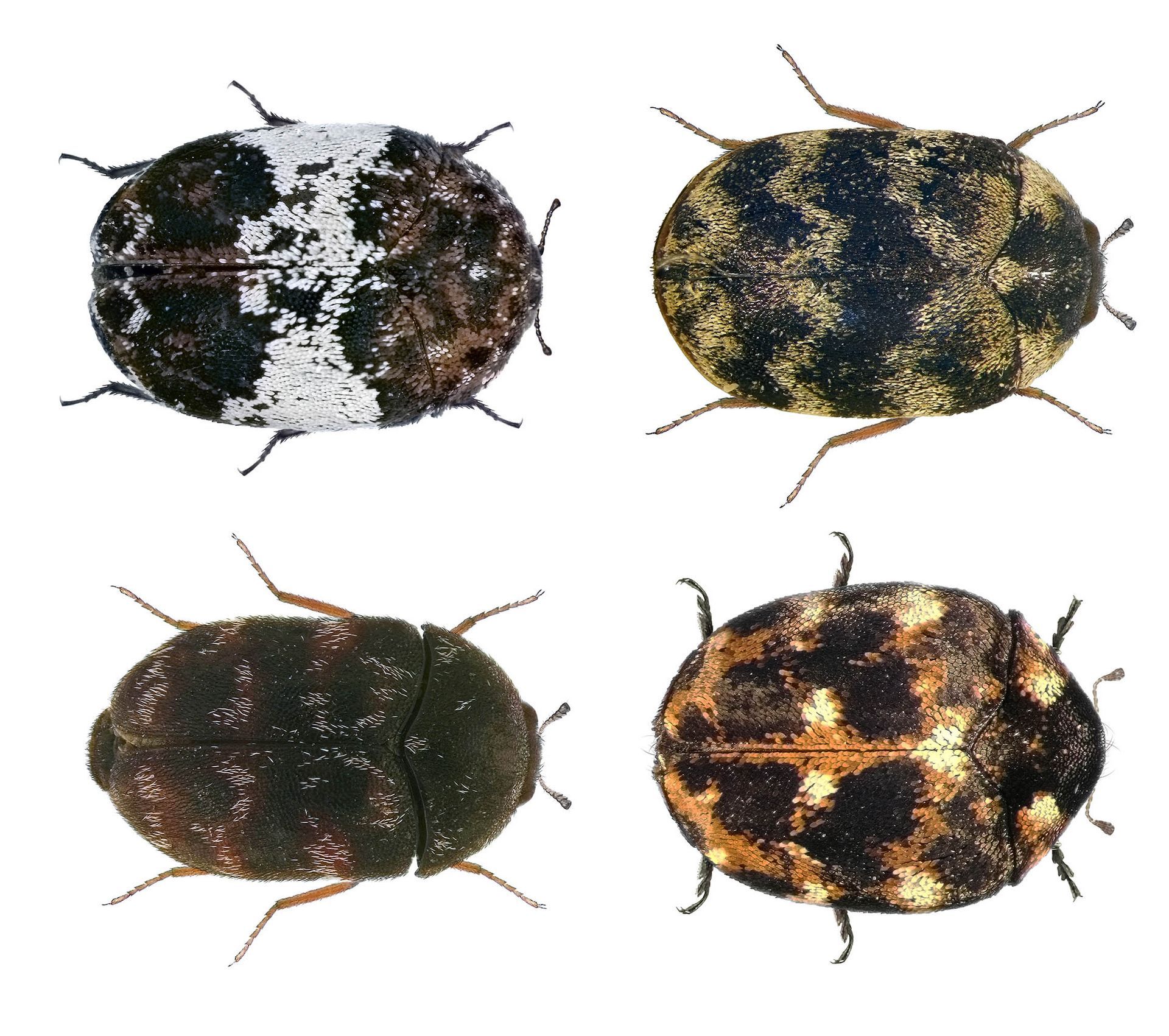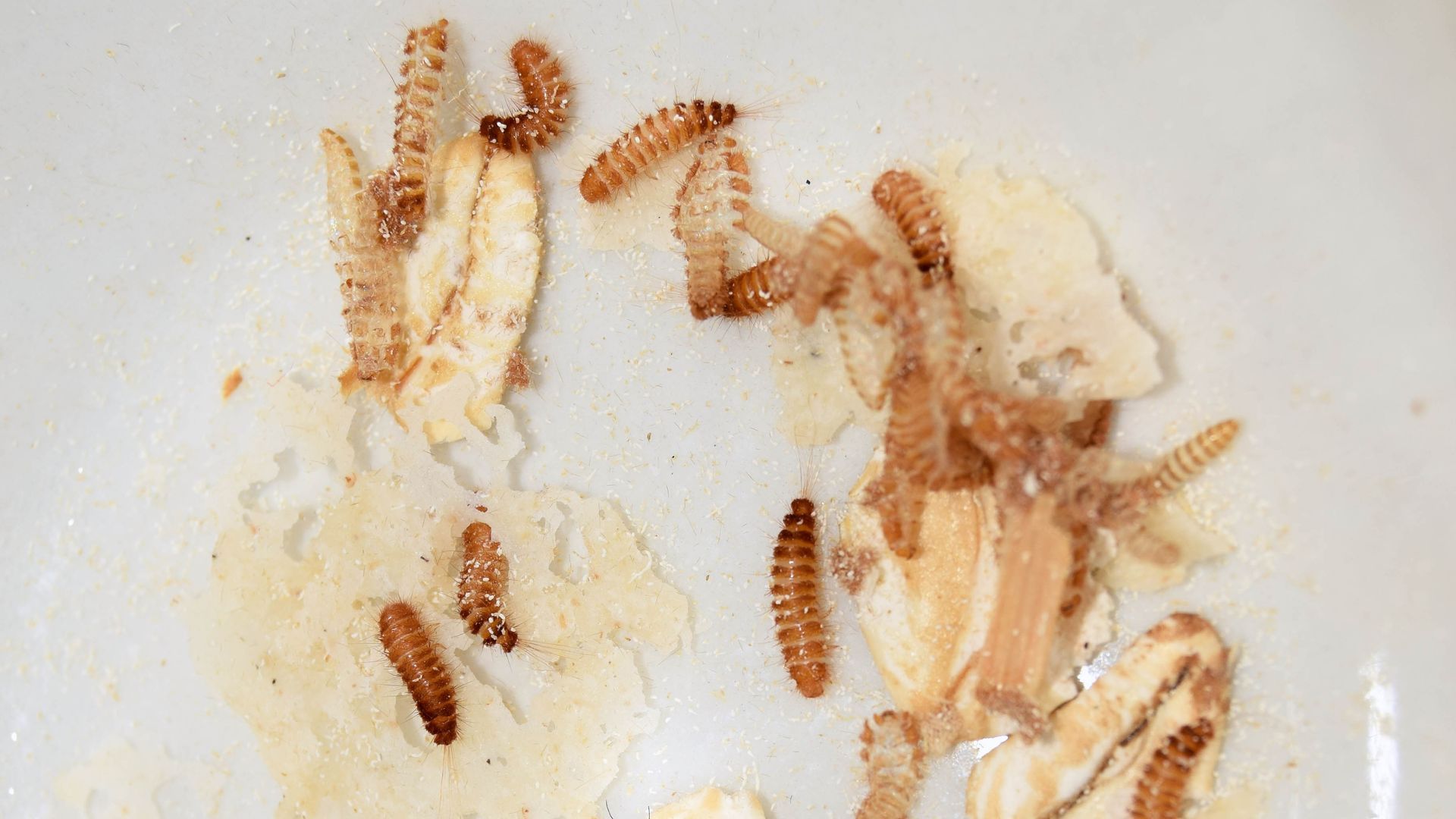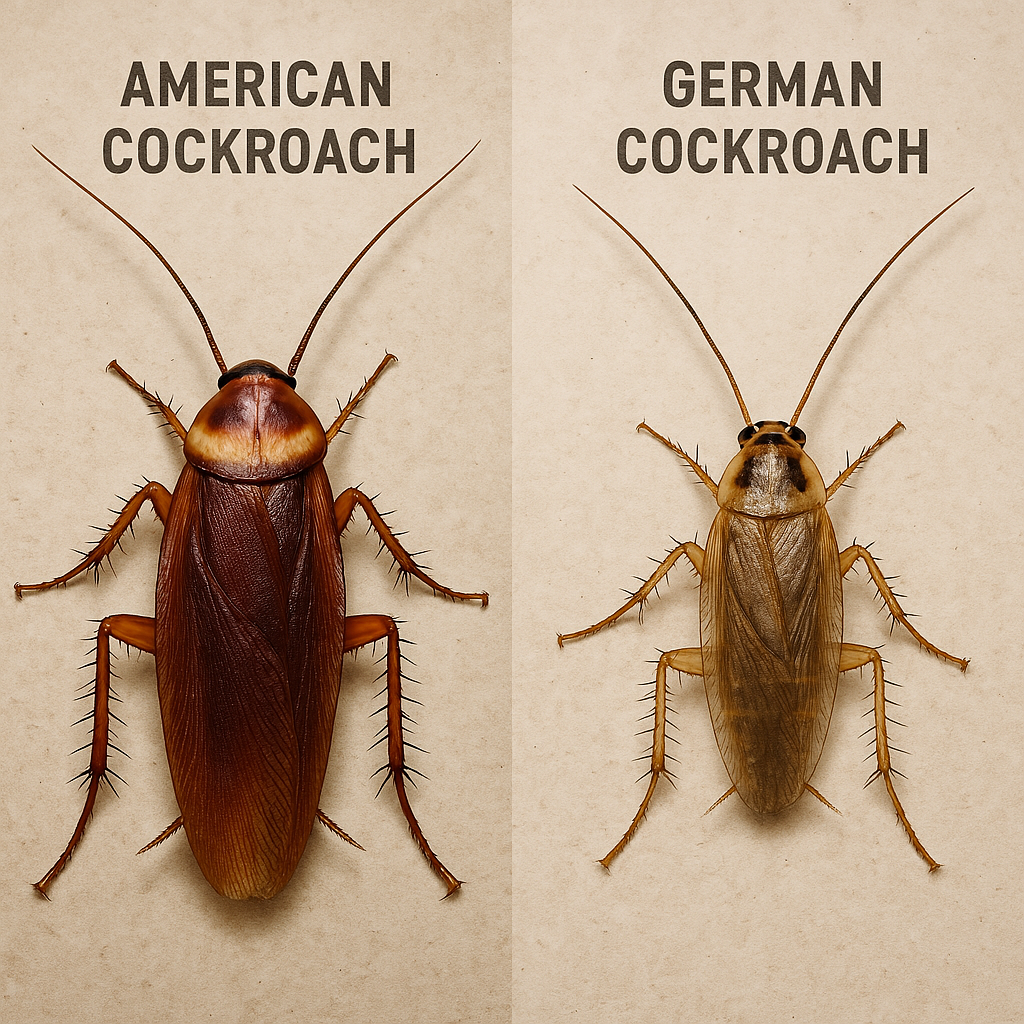What Are Carpet Beetles?

Carpet beetles are notorious for causing significant damage to various household items. While they are named for their propensity to infest carpets, they are not limited to this material. They will infest any material composed of wool, fur, felt, silk, feathers, skins, and leather. Adolescent stages of carpet beetles prefer to feed on these materials because they contain keratin, a fibrous animal protein that carpet beetle larvae can digest. They also feed on cotton and some synthetic fiber mixes that are blended with wool. Infestations can develop undetected, leading to substantial damage to vulnerable items like carpets, bedding, clothes, linens, and upholstered furniture. Recognizing the appearance of carpet beetles, their eggs, and the signs of an infestation is key to preventing and treating their presence in your home.
Carpet Beetle Identification
Carpet beetles are small, oval-shaped insects with very short, clubbed antennae. They can range in color from black to various mottled or striped patterns of white, brown, yellow, and orange. Carpet beetles develop through several life stages before reaching maturity. Once carpet beetles reach adulthood, they will typically measure between 2 mm to 5 mm in length. The early life stages start with carpet beetle eggs which are white or cream in color and are less than 1mm long.
There are several types of carpet beetles including:
- Black carpet beetles
- Varied carpet beetles
- Furniture carpet beetles
- Common carpet beetles
The black carpet beetle is the most common species, characterized by its small, black, oval shape. Its larvae are carrot-shaped, golden to dark brown, and have a tail of long hairs. The varied, furniture, and common carpet beetles are similar in appearance and habits, with adults typically having a round body with an irregular arrangement of mixed white, brownish, black, orange, or yellowish spots. The larvae of these species are about 1/5 inch long and have dense bristles and hairs at the sides and end of the body. Regardless of the type of carpet beetle, it's the larvae that cause indoor damage, not the adult beetles.
What Attracts Carpet Beetles?
Carpet beetles are attracted to a variety of environments and substances which make them an extremely common interior pest. They are particularly drawn to light, especially at night, which can lead them to enter homes through open windows and doors. Carpet beetles are drawn to natural fibers and other organic materials that contain keratin which they use as a food source. They are also attracted to accumulations of animal hair which provide an ideal source of food for larval carpet beetles. Similarly, piles of dead insects in areas such as garages or behind furniture can also attract these pests. Therefore, homes containing these materials can be particularly susceptible to carpet beetle infestation.
Carpet Beetle Diet

Carpet beetle larvae have a diverse diet and primarily feed on animal-based materials. These include wool, felt, fur, silk, feathers, and leather which they often find in items such as sweaters, scarves, coats, blankets, rugs, down pillows and comforters, upholstery, toys, and taxidermy mounts. The larvae typically feed within fabric folds and prefer items that are undisturbed like items stored for long periods in closets, chests, and boxes. Regularly used or cleaned items are less likely to be infested. Carpet beetle larvae also eat lint, hair, and organic debris that accumulates under baseboards and furniture. They can proliferate on bird nests, animal carcasses, and dead insects which are often found in attics, chimneys, and basements. Adult carpet beetles, which can live both outdoors and indoors, have a slightly different diet. They are often found on the blossoms of various flowering plants with abundant pollen such as crape myrtle, spiraea, Queen Anne's lace, buckwheat, daisies, and wild asters. Some species of carpet beetles also infest seeds, cereals, pet food, and other plant-based materials which makes them a potential problem in various areas of the home.
Carpet Beetle Life Cycle
Carpet beetles have a life cycle that begins when female beetles lay about 50-100 eggs on or near materials that are vulnerable to infestation. These materials can range from obvious items like a wool rug stored in a closet to accumulations of pet hair located in the dusty corners of a home. In a few weeks, these tiny eggs hatch into fabric-consuming larvae. As the larvae develop, they leave behind molted skins.
The life cycle of carpet beetles continues as the larvae molt 8-17 times before turning into a pupa. The larval stage may be as short as 60 days and can last over one year which depends on the species, temperature, and food availability. Full-grown larvae pupate for about 2 weeks before emerging as adults. The final stage of the carpet beetle life cycle is the adult carpet beetle which rarely lasts for more than four to eight weeks.
Carpet Beetle Lifespan
Carpet beetles undergo a full metamorphosis, that changes through four distinct stages: egg, larva, pupa, and adult. The eggs typically hatch within an average of two weeks, although this can vary depending on the species of carpet beetle and the temperature. The duration of the larval stage is also largely dependent on the species and temperature. Common carpet beetle larvae can take between two to three months to develop into pupa, varied carpet beetle larvae may require two years, and black carpet beetle larvae develop for six months to a year before pupating. The pupation stage for these beetles lasts around one to two weeks. Once they reach adulthood, carpet beetles live for an average of two months. In total, a carpet beetle’s lifespan can range from 5 – 6 months to upwards of over 2 years.
Signs of a Carpet Beetle Infestation
Carpet beetles, particularly in their larval stage, can cause significant damage to a variety of items in your home including carpets, bed sheets, linens, clothing, drapes, and other fibrous materials that contain keratin like wool, fur, felt, silk, feathers, and leather. The damage they cause is often the first sign of an infestation, with the pests tending to graze across the top and underside of carpets and rugs. This leaves behind bald patches or fraying. They can also chew clusters of holes in items like sweaters, scarves, coats, and blankets. Unlike clothes moths which create small, sporadic holes, carpet beetle larvae cause damage in large, isolated areas. They are more likely to be found feeding on fabrics and clothing that have been stored away or are untouched for long periods of time.
In addition to visible damage, other signs of a carpet beetle infestation include shed skins and fecal pellets. As carpet beetles develop, they start a molting process that requires them to shed several times. This results in them leaving behind empty exoskeletons that are translucent with a light brown tint. These molted skins can often be found in areas where the larvae feed, such as under rugs, in between piles of clothes or blankets, and around the seams of furniture. The larvae also leave behind small fecal pellets, which look like small specks similar in size to ground pepper. These are usually black or brown, but the color may vary depending on the color of their last meal. Finally, some people may experience skin irritation, rashes, or welts as an allergic reaction to carpet beetle larval hair and hemolymph, a condition known as "carpet beetle dermatitis."
Where Can Carpet Beetles Be Found?
Carpet beetles can be found in various locations within a home, often in areas where they have access to their preferred food sources. These areas can include carpets, curtains, clothes, soft furnishings, furniture, and animal beds. They can also be found in taxidermy, potpourri, bedding, plants and flowers, stored pet food, and even in stored goods such as flour and dried pasta. Essentially, any place in the home where there are organic materials, particularly those containing keratin, can potentially harbor carpet beetles. Outside the home, carpet beetles often burrow in bird nests and other organic materials, such as trees and animal carcasses.
The type of carpet beetle can also influence where they are found. For instance, black and common carpet beetles are more common in cooler climates like Europe, the Northern United States, and Canada, while varied carpet beetles are more prevalent in warmer southern regions. However, any place with warm buildings can potentially suit these insects.
How Did I Get Carpet Beetles?
Carpet beetles can find their way into homes through various means. One common way is through open doors or windows, as adult beetles are attracted to light and can fly. Once inside, they can lay their larvae on furniture, clothes, rugs, or carpets. It is important that these areas are kept clean and sanitized, otherwise carpet beetles can easily thrive inside. They can also enter a home on an item that is already infested when it is brought inside. This could include items of furniture, plants, fur, or taxidermy animals, which are particularly attractive to carpet beetles due to their preference for fabric and animal products. Therefore, it's important to be vigilant about potential entry points in the home, particularly during the warmer months when these pests are more active.
Preventing Carpet Beetle Infestations
Preventing carpet beetle infestations is often more effective than trying to eliminate them once they've taken hold. One key prevention strategy is to clean susceptible items such as woolens before storing them for long periods. This not only kills any eggs or larvae that may be present but also removes odors that attract these pests. Items should then be packed in tight-fitting plastic bags or containers. Moth balls, flakes, or crystals can be used, but they must be used correctly and safely to be effective. Valuable items like furs can be stored in cold vaults, a service offered by some furriers and department stores.
Further preventive measures include regular checks of gardens and indoor plants, as adult beetles can be attracted to these plants and end up inside. Regular vacuuming can help remove food sources for larvae and potentially kill any beetles nesting in carpets. Be sure to repair window screens and doors as well to prevent carpet beetles from entering a building. Regular cleaning of rugs, draperies, upholstered furniture, closets, and stored fabrics is beneficial. If a serious infestation occurs, it's recommended to call a qualified pest professional. Keeping doors and windows tightly sealed can minimize the invasion of adult beetles, and eliminating flowering plants and shrubs around the building can reduce pest pressure from outside.
Controlling Carpet Beetle Infestations
Controlling carpet beetle infestations requires a thorough approach. The first step is to locate all infested items which may be in dark, undisturbed areas where items are stored for long periods. These items can include clothing, rugs, and upholstered furniture. Once found, infested items should be laundered or dry-cleaned at high temperatures or discarded. Regular vacuuming of floors, carpets, and heating vents can effectively remove larvae and potential food sources for future infestations. Insecticides can be applied to infested rugs and carpets as a supplement to good housekeeping, but infested clothing or bedding should not be treated with insecticides.
Additional control methods include steam cleaning of hard surfaces, wiping or spraying surfaces with vinegar, and thorough cleaning of infected areas. If the infestation is severe, professional pest control services may be required. Non-chemical control methods such as freezing non-washable items, sanitation, and using sticky traps for monitoring activity can also be effective. Chemical control methods include the use of insecticide dusts or sprays, and in severe cases, fumigation. An alternative fumigation method is to use dry ice, which is useful for fumigating stuffed animals, pillows, and some furniture. Thermal disinfestation, which involves freezing infested items at 0 degrees Fahrenheit for at least one week, can also be effective.
Contact EcoGuard Pest Management if You Are Dealing with Carpet Beetles
Dealing with carpet beetles can be a challenging task due to their elusive nature and wide-ranging diet. While prevention and home remedies can be effective to some extent, a severe infestation may require professional intervention. If you find yourself grappling with a carpet beetle infestation, don't hesitate to reach out to EcoGuard Pest Management. Our team of experienced professionals is equipped with the knowledge and tools to effectively handle your pest problems, ensuring your home is safe and pest-free. Remember, the sooner you act, the easier it will be to manage the infestation. Call today to schedule an inspection.

















